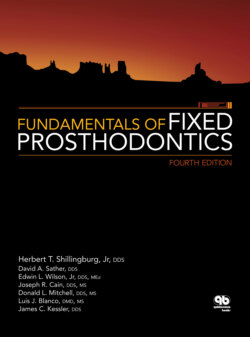Читать книгу Fundamentals of Fixed Prosthodontics - James C. Kessler - Страница 41
На сайте Литреса книга снята с продажи.
Condylar guidance
ОглавлениеChief among those aspects of condylar guidance that will have an impact on the occlusal surface of posterior teeth are the protrusive condylar path inclination and mandibular lateral translation.
The inclination of the condylar path during protrusive movement can vary from steep to shallow in different patients. It forms an average angle of 30.4 degrees with the horizontal reference plane (43 mm above the maxillary central incisor edge).17,18 If the protrusive inclination is steep, the cusp height may be longer. However, if the inclination is shallow, the cusp height must be shorter (Fig 2-16).
Immediate mandibular lateral translation is the lateral shift during initial lateral movement. If immediate lateral translation is great, then the cusp height must be shorter or the fossa width wider (Fig 2-17). With minimal immediate translation, the cusp height may be made longer or the fossa may be narrower.
Ridge and groove directions are affected by the condylar path, particularly the lateral translation. The effects are observed on the occlusal surface of a mandibular molar and premolar with the paths traced by the palatal cusps of the respective opposing maxillary teeth. The working path is traced on the mandibular tooth in a lingual direction, and the nonworking path is in a distofacial direction. The nearer the tooth is to the working-side condyle anteroposteriorly, the smaller the angle between the working and nonworking paths (Fig 2-18). The farther the tooth is located from the working-side condyle, the greater the angle between the working and nonworking condyles. When immediate lateral translation is increased, the angle also becomes more oblique.
Fig 2-17 A pronounced immediate lateral translation requires that the cusps be short or the fossa wider (a), while a gradual lateral translation allows the cusps to be longer or the fossa narrower (b).
Fig 2-18 The angle between the working (W) and nonworking (NW) paths is greater on teeth located farther from the condyle.
